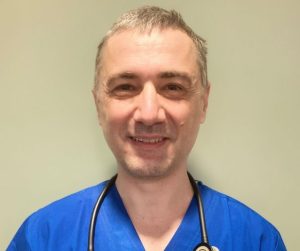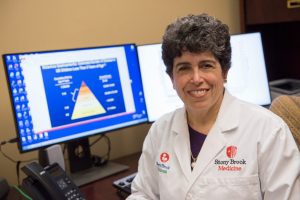First Amendment rights cannot be stopped
Legislator Steve Englebright (D-Setauket) believes that constituents can be controlled and silenced by offering candy as if they were 5 year olds. It’s insulting and degrading that grown adults who speak out against injustices and understand how to use their First Amendment rights to free speech are being silenced.
No, Steve, a Life Saver isn’t going to make me stop speaking out against the draconian rules that [Suffolk] County passes that harm the public’s general welfare by turning the county police department against the Latino population. The presiding officer infringed and trampled on my First Amendment rights because he didn’t like what I said.
Let’s face it, the appearance of senior women speaking at public meetings exercising a constitutional protection of free speech surrounded by fully armed sheriff’s officers is bad public relations for the legislative body in a democracy.
Lisa Sevimli, Patchogue
We do not need another freight station
I wholeheartedly agree with Frank Konop [Smithtown freight yard is a threat to our community, [TBR News Media, Jan. 23] that the proposed Townline Rail Terminal will do more harm than good to residents of Smithtown township. However, his attempt to link it to the wildfires in southern California is way off base.
This has nothing to do with “social justice policies.” Regarding the California fires, it’s false that they were related in any way to redirecting reservoir water to save fish. State reservoirs storing water for southern California are at or near record highs.
The elephant in the room is global warming. Although it’s impossible to narrowly tie it directly to a particular disaster, it’s foolish to deny its role in the increasing prevalence of wildfires, droughts, floods and freak weather. In March 2024 the Smokehouse Creek fire burned over one million acres in the Texas Panhandle, compared with more than 40,000 acres burned in California thru January 2025. In October 2024 in Valencia, Spain, 232 people were killed by a year’s worth of rain falling in a few hours. Right here in Smithtown we were hit by a “rain bomb” last August that destroyed Stony Brook Pond and Stump Pond and flooded town hall. The Main Branch of Smithtown Library is still closed.
Getting back to the TRT, there are lots of questions. This facility will be used not only to ship incinerator ash as well as construction and demolition debris off Long Island, but also to transport construction materials, vehicles and other undefined goods and commodities onto Long Island. What limitations are there? Will propane, heating oil or hazardous materials be among these commodities? We don’t know. What need is there for two transfer buildings, track to accommodate 161 freight cars and a fleet of 50 trucks if this facility will run only one 27-car train in and out per day as its sponsor claims? Will the tracks become a magnet for illegal dumping, attracting rats and mosquitos? TRT will undoubtedly have impacts beyond wrecking the Kings Park residential community it’s adjacent to, including the pollution emitted by the 1970s era diesel locomotives pulling all those freight cars.
The culprit behind this misbegotten proposal is not “social justice policies” or the “Green New Deal,” but our own Smithtown Town Board, which unanimously railroaded it through (pun intended) every step of the way. It’s now proposing to change town zoning code to add a new use called “rail freight terminal” to districts zoned Light Industrial, of which there are many, including Flowerfield, around town. Flowerfield was once a Long Island Rail Road station with its own siding track. Could this rezoning affect the disposition of Flowerfield? The Smithtown Town Board is supposed to protect the interests of Smithtown residents. But apparently, they’re so sure of being reelected due to their party affiliation that they presume it’s safe to ignore overwhelming opposition to TRT from the community. And who’s to say they’re wrong?
David Friedman, St. James
Presidency of Dr. Shirley Strum Kenny and Dr. Jack Marburger
As the former president of the Three Village/Stony Brook Soccer Club from 1990 to 2002 and 2010 to 2017, I read with great interest your article on the presidency of Dr. Shirley Strum Kenny and her impact upon the Three Village community. While Dr. Kenny’s support for the local community and especially our local soccer club was second to none, I do not want the article to give the impression, as I think it does, that her predecessor, Dr. Jack Marburger, was not interested in the local community and was only interested in the science aspect of the university. Nothing could be further from the truth, especially as it related to the development of the soccer complex next to the P lot at [Stony Brook] University.
Prior to our request to be able to develop the unused land for a variety of soccer fields, our local soccer club played all of their games at our local schools, forcing our children and families to go from one site to another, or be forced to miss their games. Upon our request to Dr. Marburger to be able to develop the fields, he played a major role in giving us permission to develop the property and ensuring our success even in the face of considerable opposition from the local neighbors and others. Knowing that such a complex would be of great benefit to the larger community, Dr. Marburger made sure that we received a permit from his office and in fact only charged the soccer club $1 a year for the use of the property. I think it is fair to say that without his support and understanding of what such a use would mean to the thousands of children and families in our community there would have been no soccer fields for our community to use on the university campus.
Upon her acceptance of her position, Dr. Kenny continued her support for the decision of Dr. Marburger with regard to the soccer fields, allowing the permit to continue for $1 a year and allowing the soccer club to build a multi-use building which contained both “real bathrooms” for our families as well as a concession stand. In addition she allowed for the soccer club to hold various outdoor and indoor tournaments on the campus, at no charge, including the major tournament on Long Island at that time, the Long Island Junior Soccer League championships. She was a frequent visitor to the fields on Sundays when over two thousand of our children played during the day. She made sure her staff was always supportive of our efforts to improve the complex and supported our efforts to gain a state grant which we did with the support of former State Senator Jim Lack and former State Assemblyman Steve Englebright.
Both Dr. Marburger and Dr. Kenny understood that Stony Brook University is more than just buildings and research. It is a community asset of the Three Villages and as such must be engaged with the local community in more ways that just selling tickets to various events. Unfortunately, neither of their two successors understood how a state university and a larger community must be engaged with each other, to the point where the soccer complex was taken over by the recreation department and charged the local soccer club over $100,000 each year for the ability of our local children to play soccer on land which had been developed by the local soccer club. Unfortunately they looked at the soccer fields solely as a money maker and not as a community benefit, to the point where they now charge for almost everything, significantly reduced the amount of time allotted for games and practices and have closed the building which was built for the benefit of our families.
While one may think that this is all history, it is not, especially as Stony Brook University engages once again in the selection of a new president. The selection committee and the SUNY Board of Trustees must understand that Stony Brook University must be part of the community, as promoted by both Dr. Kenny and Dr. Marburger, and not merely located in our community as made clear by their successors who gratefully have gone on to other places far from here. One would hope that the new president will understand and promote a concept of togetherness and mutual commitment to each other and not just what is good for the university. We hope that the history of what Dr. Kenny and Dr. Marburger accomplished will be the type of history which the new president will provide and not the type of history which their successors failed to provide. Our community is a better place to live when the university understands that it is part of the community and not just located here.
Mitchell H. Pally, Former President
Three Village Soccer Club
1992-2002; 2010-2017


















